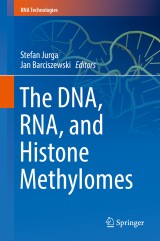Details

The DNA, RNA, and Histone Methylomes
RNA Technologies
|
171,19 € |
|
| Verlag: | Springer |
| Format: | |
| Veröffentl.: | 28.08.2019 |
| ISBN/EAN: | 9783030147921 |
| Sprache: | englisch |
Dieses eBook enthält ein Wasserzeichen.
Beschreibungen
<p></p><p>This book reviews the chemical, regulatory, and physiological mechanisms of protein arginine and lysine methyltransferases, as well as nucleic acid methylations and methylating enzymes. Protein and nucleic acid methylation play key and diverse roles in cellular signalling and regulating macromolecular cell functions.</p><p>Protein arginine and lysine methyltransferases are the predominant enzymes that catalyse S-adenosylmethionine (SAM)-dependent methylation of protein substrates. These enzymes catalyse a nucleophilic substitution of a methyl group to an arginine or lysine side chain nitrogen (N) atom. Cells also have additional protein methyltransferases, which target other amino acids in peptidyl side chains or N-termini and C-termini, such as glutamate, glutamine, and histidine. All these protein methyltransferases use a similar mechanism. In contrast, nucleic acids (DNA and RNA) are substrates for methylating enzymes, which employ various chemical mechanisms to methylatenucleosides at nitrogen (N), oxygen (O), and carbon (C) atoms.</p><p> </p><p>This book illustrates how, thanks to there ability to expand their repertoire of functions to the modified substrates, protein and nucleic acid methylation processes play a key role in cells.</p><br><p></p>
Chapter 1. Establishment, Erasure and Synthetic Reprogramming of DNA Methylation in Mammalian Cells.- Chapter 2. Origin and Mechanisms of DNA Methylation Dynamics in Cancers.- Chapter 3. CpG Islands Methylation Alterations in Cancer: Functionally Intriguing Security Locks, Useful Early Tumor Biomarkers.- Chapter 4.<b> </b>Histone and DNA Methylome in Neurodegenerative, Neuropsychiatric and Neurodevelopmental Disorders.- Chapter 5. DNA Methylation in Neuronal Development and Disease.- Chapter 6. Functional Implications of Dynamic DNA Methylation for the Developing, Aging and Diseased Brain.- Chapter 7. The Methylome of Bipolar Disorder: Evidence from Human and Animal Studies.- Chapter 8. DNA Methylation in Multiple Sclerosis.- Chapter 9. Early Life Stress and DNA Methylation.- Chapter 10. Regulation of 5-hydroxymethylcytosine Distribution by the TET Enzymes.- Chapter 11. Epigenetic Alterations: The Relation Between Occupational Exposure and Biological Effects in Humans.- Chapter 12. DNA Methylation: Biological Implications and Modulation of its Aberrant Dysregulation.- Chapter 13. Functions and Dynamics of Methylation in Eukaryotic mRNA.- Chapter 14. The Role of mRNA m<sup>6</sup>A in Regulation of Gene Expression.- Chapter 15. G9a and G9a-like Histone Methyltransferases and Their Effect on Cell Phenotype, Embryonic Development, and Human Disease.- Chapter 16. Biomolecular Recognition of Methylated Histones.- Chapter 17. The Role of Protein Lysine Methylation in the Regulation of Protein Function - Looking Beyond the Histone Code.- Chapter 18. Secondary Structures of Histone H3 Proteins with Unmethylated and Methylated Lysine-4 and -9 Resiudes; Characterization Using Circular Dichroism Spectroscopy.- Chapter 19. Asymmetric Dimethylation on Arginine (ADMA) of Histones in Development, Differentiation and Disease.- Chapter 20. A Switch for Transcriptional Activation and Repression: Histone Arginine Methylation.- Chapter 21. Aberrant Epigenomic Regulatory Networks in Multiple Myeloma and Strategies for their Targeted Reversal.- Chapter 22. Metabolic Deregulations Affecting Chromatin Architecture: One-carbon Metabolism and Krebs Cycle Impact Histone Methylation.- Chapter 23. Histone Methylome of the Human Parasite <i>Schistosoma Mansoni.</i>
<p>Prof. Dr. hab. Stefan Jurga, </p>
<p>Adam Mickiewicz University, Nanobiomedical Center,</p><p>Poznań, Poland</p><p>stjurga@amu.edu.pl</p>
Prof. Dr.hab Jan Barciszewski, <p></p><p>Institute of Bioorganic Chemistry of the Polish Academy of Sciences, Poznań, Poland and</p><p>Adam Mickiewicz University, Nanobiomedical Center, Poznań, Poland</p>
<p>jan.barciszewski@ibch.poznan.pl</p>
<p>Adam Mickiewicz University, Nanobiomedical Center,</p><p>Poznań, Poland</p><p>stjurga@amu.edu.pl</p>
Prof. Dr.hab Jan Barciszewski, <p></p><p>Institute of Bioorganic Chemistry of the Polish Academy of Sciences, Poznań, Poland and</p><p>Adam Mickiewicz University, Nanobiomedical Center, Poznań, Poland</p>
<p>jan.barciszewski@ibch.poznan.pl</p>
<p>This book reviews the chemical, regulatory, and physiological mechanisms of protein arginine and lysine methyltransferases, as well as nucleic acid methylations and methylating enzymes. Protein and nucleic acid methylation play key and diverse roles in cellular signalling and regulating macromolecular cell functions.</p><p>Protein arginine and lysine methyltransferases are the predominant enzymes that catalyse S-adenosylmethionine (SAM)-dependent methylation of protein substrates. These enzymes catalyse a nucleophilic substitution of a methyl group to an arginine or lysine side chain nitrogen (N) atom. Cells also have additional protein methyltransferases, which target other amino acids in peptidyl side chains or N-termini and C-termini, such as glutamate, glutamine, and histidine. All these protein methyltransferases use a similar mechanism. In contrast, nucleic acids (DNA and RNA) are substrates for methylating enzymes, which employ various chemical mechanisms to methylate nucleosides at nitrogen (N), oxygen (O), and carbon (C) atoms.</p><p> </p><p>This book illustrates how, thanks to there ability to expand their repertoire of functions to the modified substrates, protein and nucleic acid methylation processes play a key role in cells.</p><div><br></div>
Comprehensively reviews the chemical, regulatory, and physiological mechanisms of protein arginine and lysine methyltransferases Highlights clinical applications of epigenetic editing in cancer treatment and aging Highlights hot topics such as cellular plasticity, novel biomarkers and genome-wide association studies
Diese Produkte könnten Sie auch interessieren:

Aktinische Keratosen - medizinisches Grundwissen und NEUE Therapieansätze (Carcinomata in situ)

von: Hellene von Waldgraben

9,99 €

Manual clínico de los antidepresivos

von: Victor R. Uriarte Bonilla, Victor R. Uriarte Editorial Alfil, S. A. de C. V.

23,99 €














